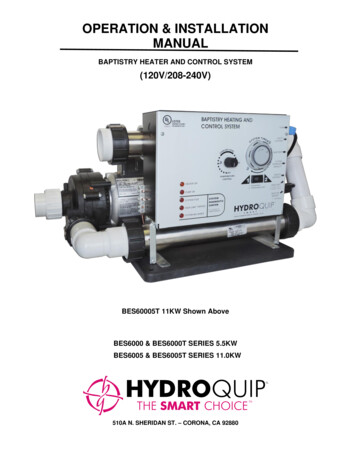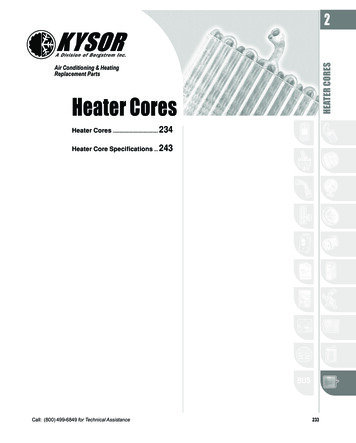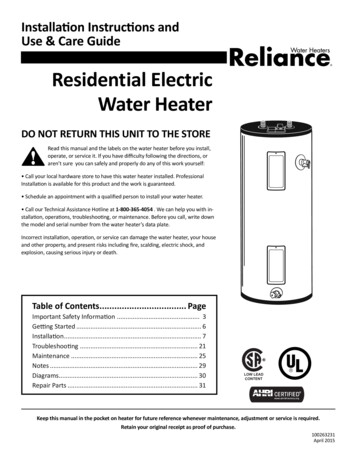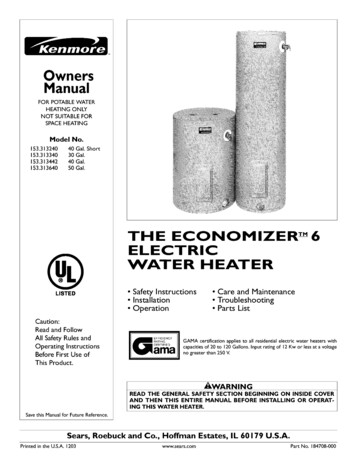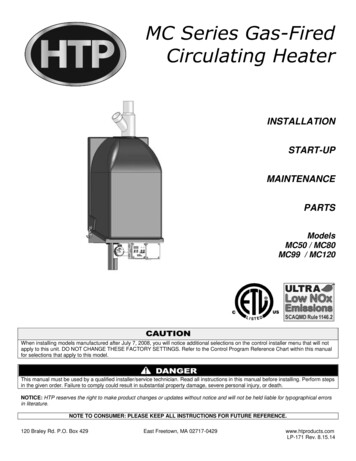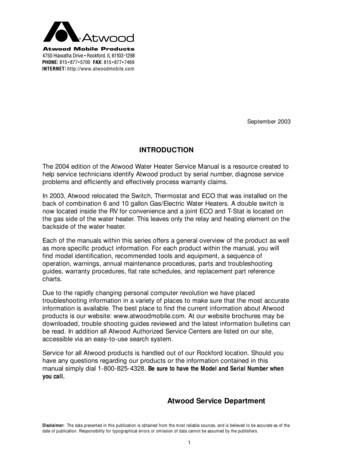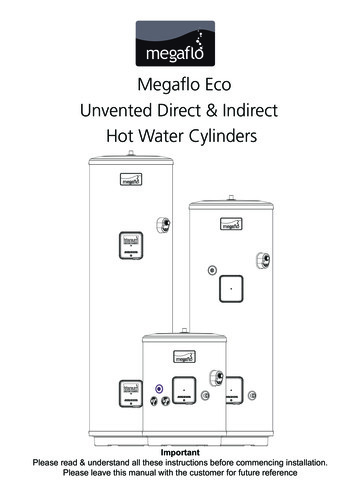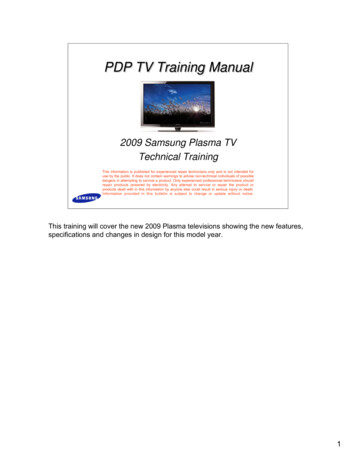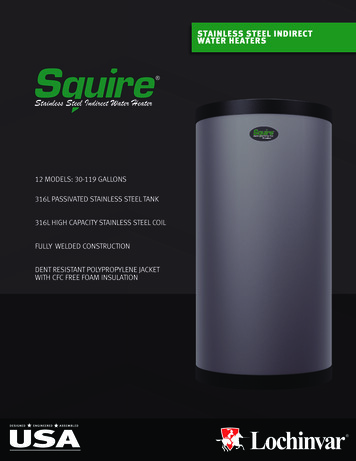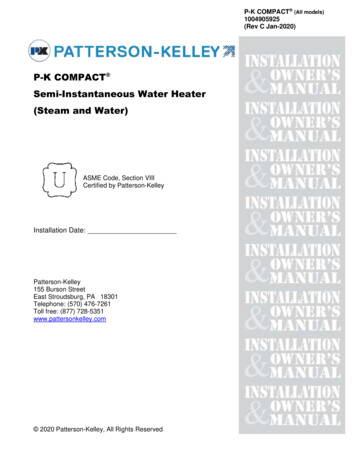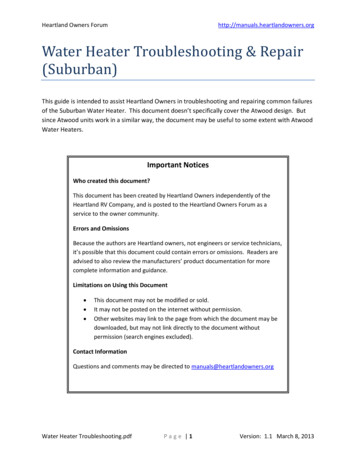
Transcription
Heartland Owners Forumhttp://manuals.heartlandowners.orgWater Heater Troubleshooting & Repair(Suburban)This guide is intended to assist Heartland Owners in troubleshooting and repairing common failuresof the Suburban Water Heater. This document doesn’t specifically cover the Atwood design. Butsince Atwood units work in a similar way, the document may be useful to some extent with AtwoodWater Heaters.Important NoticesWho created this document?This document has been created by Heartland Owners independently of theHeartland RV Company, and is posted to the Heartland Owners Forum as aservice to the owner community.Errors and OmissionsBecause the authors are Heartland owners, not engineers or service technicians,it’s possible that this document could contain errors or omissions. Readers areadvised to also review the manufacturers’ product documentation for morecomplete information and guidance.Limitations on Using this Document This document may not be modified or sold.It may not be posted on the internet without permission.Other websites may link to the page from which the document may bedownloaded, but may not link directly to the document withoutpermission (search engines excluded).Contact InformationQuestions and comments may be directed to manuals@heartlandowners.orgWater Heater Troubleshooting.pdfPage 1Version: 1.1 March 8, 2013
Heartland Owners Forumhttp://manuals.heartlandowners.orgWater Heater Troubleshooting & Repair(Suburban)Table of ContentsTroubleshooting Electric Mode. 4Electric Switches . 4Main 110V Power Switch . 4Secondary 110V Power Switch . 4How Can I Tell If There’s Water in the Water Heater? . 5Testing the 110V Circuit to the Heating Element . 6Repeated Over Temperature Shutdowns . 6110V Wiring Diagram . 7Accessing the electric components to test for power . 7110V Not Getting to the Heating Element . 8110V is Present at the Heating Element . 8Checking Resistance of the Heating Element . 9Check Neutral before Replacing the Element . 9Replacing the Heating Element and Gasket. 9Troubleshooting LP Mode . 11Propane Supply . 11If You Suspect a Problem with Propane Flow . 11Hi-Limit/ECO Switch and Thermostat Assembly . 12Checking the Hi-Limit/ECO Switch and Thermostat Assembly . 12Obstruction of the Air Intake . 13Other Problems with the LP Side of the Water Heater . 13Warranty . 13Changing the Check Valve . 14Routine Maintenance on the Water Heater . 17Draining the Water Heater / Winterizing . 17Anode Rod. 18Water Heater Troubleshooting.pdfPage 2Version: 1.1 March 8, 2013
Heartland Owners Forumhttp://manuals.heartlandowners.orgAnode Rod Life . 19Seeping/Dripping . 19Unpleasant sulphur or rotten-egg odor . 20For Suburban Water Heaters . 20For Atwood Water Heaters . 20Water Heater Troubleshooting.pdfPage 3Version: 1.1 March 8, 2013
Heartland Owners Forumhttp://manuals.heartlandowners.orgWater Heater Troubleshooting & Repair(Suburban)This guide is based on the Suburban Water Heater commonly found in most Heartland RVs.CAUTION: Electricity is dangerous. Many of us are comfortable with checking 110V AC and 12VDC circuits and are confident we can do so without damaging the circuits or causing injury toourselves. If you are not comfortable around electrical circuits, you should consider letting acertified technician diagnose and correct the problem.Troubleshooting Electric ModeCAUTION: It’s critically important that you check that the water heater is full of water before turningon the 110V heat. If there’s no water, the heating element will burn out very quickly and will have tobe replaced.Electric SwitchesMain 110V Power SwitchThe main 110V switch is operated just like a light switch and most will illuminate when power flowsthrough the switch. If the light switch normally does light up, but is not lighting up now, there may be aloose connection on the back of the switch, or the 110V circuit breaker may have tripped.Secondary 110V Power SwitchAgain, it’s critically important that you check that the water heater is full of water before turning onthe 110V heat. If there’s no water, the heating element will burn out very quickly and will have to bereplaced. Of course, even if your trailer is in warranty, burning out the electric element is considereduser error, which is not covered by the warranty against manufacturing defects.If you’re not sure how to check for water in the water heater, see the section below.The secondary 110V switch is a rocker-type that can be pinned in the OFF position with a small cotterpin. On a new trailer, to turn it on the first time, you have to remove the cotter pin and rock the switchto the ON position.You can leave the switch ON permanently. But be aware that when you winterize, the water heatertank will be emptied, and if subsequently, a visitor turns on the inside 110V switch, the element will beruined. So whenever the water heater tank is emptied, it’s a good idea to turn the secondary switchto the OFF position.Water Heater Troubleshooting.pdfPage 4Version: 1.1 March 8, 2013
Heartland Owners Forumhttp://manuals.heartlandowners.orgThe secondary switch is accessed by removing the cover from the back side of the water heater. Thelocation on the RV will vary, but it will look something like this.On the Suburban, with the cover off, you’ll find the secondary switch in the bottom left corner.How Can I Tell If There’s Water in the Water Heater?First, check that the Water Heater Bypass is in the normal operating position. On many trailers, there isa diagram on the basement storage door showing normal and bypass settings. If you have a UniversalDocking Center (UDC) for water connections, the Water Heater Bypass is probably located in the UDC.On other trailer configurations, the bypass valve will usually be inside, near water connections to thewater heater, accessible by way of a drawer or panel.Second, open a faucet and check that water flows equally when the faucet is full to Cold and full to Hotsettings.CAUTION: If the water heater is in bypass mode, checking water flow will be misleading. Inbypass mode, with an empty water heater, the cold water supply will flow through boththe hot and cold lines.While you’re checking things, make sure if you have an outside shower that the faucets are turned off.If you leave them open, hot and cold water will mix and you will get lukewarm water from other faucets.Water Heater Troubleshooting.pdfPage 5Version: 1.1 March 8, 2013
Heartland Owners Forumhttp://manuals.heartlandowners.orgTesting the 110V Circuit to the Heating ElementFirst of all, make sure that both 110V switches are turned on. The primary switch, if it normally lightsup, should be lit. If it’s not lit, the circuit breaker may have tripped, or you may have a loose connectionon the back of the light switch.In normal operation, there is a thermostat that determines when to turn on the heating element andcloses the 110V circuit to the heating element as the water cools. When the water is hot, thethermostat opens the electrical circuit so that the water doesn’t get too hot.If the thermostat fails to open the circuit, the water temperature will continue to increase. To avoid adangerous over-temperature condition, a second sensor, called a Hi-Limit or Electric Cut Off (ECO) opensthe electrical circuit to the element. That switch then stays open, interrupting power to the heatingelement until you press the RESET button. The right-hand button is the electric circuit reset and the lefthand is the LP reset.If both power switches are ON, but the electric element is not heating the water, press both resetbuttons on the back of the water heater.If pressing the reset buttons restores operation, it’s an indicator that the thermostat may have failed tocut power to the heating element. This would have allowed the water temperature to reach too high alevel. The Hi-Limit/ECO switch is the failsafe device that cuts power when the thermostat fails to do so.Repeated Over Temperature ShutdownsIf the heating element repeatedly shuts down and operation is restored by pressing the reset buttons,the Thermostat assembly (including the Hi-Limit/ECO switch) needs to be replaced.CAUTION: Never bypass the Hi-Limit/ECO or Thermostat. Doing so could result in an unsafecondition causing property damage or personal injury.Water Heater Troubleshooting.pdfPage 6Version: 1.1 March 8, 2013
Heartland Owners Forumhttp://manuals.heartlandowners.org110V Wiring DiagramThis diagram shows the electric flow on the back of the water heater, through the secondary switch, tothe Hi-Limit/ECO, to the Thermostat, and then to the electric element. Note that the black wire is hot,and the white wire goes to neutral.Accessing the electric components to test for powerThe left picture shows the reset buttons which can be pressed with the cover in place. The right pictureshows the Hi-Limit/ECO and Thermostat assemblies with cover removed. The right assembly is for the110V circuit and the left is for the 12V circuit to the LP side of the water heater. Voltage readings maybe taken on the wiring terminals for these devices. Note that the sensor on the right carries 110V ACand the sensor on the left carries 12V DC.Water Heater Troubleshooting.pdfPage 7Version: 1.1 March 8, 2013
Heartland Owners Forumhttp://manuals.heartlandowners.orgThe left-hand picture above shows the Electric Element Cover, held in place by 2 screws. After removingthe cover, use a Volt Meter set to 110V AC range to determine if 110V is reaching the electric element.110V Not Getting to the Heating ElementIf the volt meter doesn’t show 110V at the electric element terminals, work backwards to determinewhere the circuit has been interrupted. Test for voltage at the thermostat, and at the Hi-Limit/ECOsensor.If voltage is present at one side of the Hi-Limit/ECO/Thermostat device, but not at the other, and thewater is cool, that device will need to be replaced. Turn off both power switches, make sure the wateris cool, and drain the water heater before replacing.CAUTION: Never bypass the Hi-Limit/ECO or Thermostat. Doing so could result in an unsafecondition causing property damage or personal injury.If there is NO power on either terminal of the Hi-Limit/ECO/Thermostat, check for power on both sidesof the secondary 110V switch when the switch is on. Turning the switch off should interrupt powerflow.110V is Present at the Heating ElementIf voltage at the heating element is correct (measured from the black wire’s terminal to frame ground)that would usually mean the electric element is defective or burned out and needs to be replaced.Before changing the element, you should do the additional tests that follow.Water Heater Troubleshooting.pdfPage 8Version: 1.1 March 8, 2013
Heartland Owners Forumhttp://manuals.heartlandowners.orgChecking Resistance of the Heating ElementThe heating element normally has a resistance of 14.5-17 Ohms. Turn both power switches off. Beforeproceeding, use the voltmeter to verify there is no voltage at the heating element.CAUTION: If you touch your meter lead to a hot wire (110V) while set to read continuity, youcould damage your meter and possibly injure yourself.After verifying no voltage at the element, remove one of the heating element wires to check theresistance. If resistance is infinite (open) replace the element.Check Neutral before Replacing the ElementBefore replacing the element based on finding voltage at the element, you should turn off power to thewater heater (both switches), and check continuity of the white wire terminal (neutral), to the neutralpin of the closest RV outlet (the larger pin in the outlet).CAUTION: If you touch your meter lead to a hot wire(110V) while set to read continuity, you could damageyour meter and possibly injure yourself. Before checkingcontinuity, you should set the meter to 110V and verifywhich pin is hot and which pin is neutral. Then switch toOhms mode to check continuity.Replacing the Heating Element and GasketReplacement Suburban heating elements may be purchased from most RV dealers, or online.Compatible heating elements are also available at many big-box hardware stores.1.2.3.4.5.Turn off both 110V power switches and the LP switch and make sure the water has cooled.Follow the procedure later in this document to drain the water heater.Remove the cover from the heating element.Remove the wires from the heating element and gently bend them back away from the opening.The gas burner assembly barrel blocks access to the heating element. Before removing theburner assembly light a stove burner then shut off the LP supply at the tanks. The burner will goout when the residual pressure is gone. That step reduces gas pressure in the lines duringdisassembly of the burner assembly.6. The burner assembly (the barrel part) is likely the only thing needed to be removed and you maynot have to loosen any gas fittings. The gas tube & orifice should be resting in a hole in the endof the burner.7. Using a 7/16” wrench, remove the burner assembly barrel.Water Heater Troubleshooting.pdfPage 9Version: 1.1 March 8, 2013
Heartland Owners downers.orgUsing a 1-1/2” socket or wrench, or a specialized tool such as the Camco 9883 Element Wrench,rotate the heating element counter-clockwise to loosen and remove it. If stuck, use penetratingoil to loosen it.Clean the mounting surface where the new gasket will be applied so that it makes good contact.Install the new gasket and new heating element. Applying a coating of plumber’s grease to thenew gasket will help prevent leaks (use a product safe for rubber gaskets). Using anti-seize onthe element threads will make it easier to remove the element in the future.Tighten to compress the gasket, but do not over tighten.Reattach wires and replace the cover.Reconnect the burner assembly and be sure the gas fittings are tight. Turn on the gas supply,test the joints with a soapy water spray before & during first lighting of the burner.Install the anode rod and fill the water heater.Test for correct operation.CAUTION: Propane is extremely dangerous. Any time that gas fittings are loosened orremoved, after reinstalling/tightening, it’s critically important that you ensure there are nogas leaks.Water Heater Troubleshooting.pdfP a g e 10Version: 1.1 March 8, 2013
Heartland Owners ting LP ModeTo operate in LP mode, turn on the LP rocker switch in your control panel. A small indicator light willilluminate for about 15 seconds to let you know that the ignition sequence is underway. During the 15seconds, the control board will attempt to purge air from the propane feed line and then will attempt tolight the propane 3 times over the next 6 seconds. If it fails, the water heater will lock the LP operationfor safety reasons and the light will stay on. To clear the lockout, turn the switch off for 10 seconds andthen turn on again to retry. Note that if the water in the tank is already heated, the ignition sequencemay not occur until the water cools to less than 100 degrees.Note: If the DC voltage falls below 12V, the water heater control board may not operate correctly,causing a failure. This could easily happen while boon docking, but could also happen for other reasons.CAUTION: Propane is extremely dangerous. Because of the explosive dangers involved withpropane, the advice presented here cannot go beyond simple checks of the propane operation.If the control board, ignition components, gas valve, burner operation, or flame sensingdevices are suspected of failure, you should find a certified technician to correct the problem.If you smell propane while trying to diagnose a water heater problem, STOP and wait for thepropane to dissipate. If the smell continues, close both LP tank valves and get help.Propane SupplyIn order for the LP side of the Water Heater to function correctly, it needs 11 Water Column Inches ofpropane pressure. Since this is checked with specialized equipment, we can’t check it directly withoutcalling in a certified technician who has the appropriate tools.One proxy for the specialized equipment is the RV Furnace. The furnace relies on good propane flow inorder to operate correctly. If the furnace is operating correctly, propane flow is probably ok. If it’s notpractical to run the furnace, another proxy would be an LP generator, if you have one. It’s also verydemanding on propane flow. The next choice would be to check at the range top in the kitchen. If allburners operate with normal flame, that’s a good indicator, but unfortunately, it may not be definitive.If You Suspect a Problem with Propane FlowBesides an empty tank, the most common causes of poor propane flow are: Tank valve opened too quickly, deploying the overflow protection device inside the tank.Failing high-pressure pigtail between tank and regulator.Failing high-pressure regulator (Between the tank and the auto-changeover regulator. On 5thwheels, usually by the door side tank.)Failing auto-changeover regulator.Close the valve on the tank being used, wait a few seconds, and re-open it very slowly to reset theoverflow protection device. If that doesn’t resolve the problem, try switching the auto-changeoverregulator to the other LP tank and slowly open that tank valve. If that doesn’t resolve the problem,Water Heater Troubleshooting.pdfP a g e 11Version: 1.1 March 8, 2013
Heartland Owners Forumhttp://manuals.heartlandowners.orgswap the position of the LP tanks to bypass a possible failing high-pressure pigtail, or failing highpressure regulator.If none of those actions resolve the problem, and you still suspect a problem with poor propane flow,you may have to replace the auto-changeover regulator.Hi-Limit/ECO Switch and Thermostat AssemblyIf the direct spark ignition is not operating, and there is therefore no attempt to ignite the propanewhen the LP switch is turned on, an over temperature condition may have occurred. press both resetbuttons. Try operating the LP switch again.Checking the Hi-Limit/ECO Switch and Thermostat AssemblyIf pressing the reset buttons doesn’t resolve the problem, remove the cover from the reset buttons andcheck for 12V DC at the Hi-Limit/ECO Switch and at the Thermostat. If 12V DC is present on the topconnector, but not on the bottom connector, and water is cool, the Hi-Limit/ECO Switch / Thermostatassembly needs to be replaced. Turn off all power switches, close the LP tank valves, drain the tank, andreplace the assembly. Then refill the tank and retry LP operation.Water Heater Troubleshooting.pdfP a g e 12Version: 1.1 March 8, 2013
Heartland Owners Forumhttp://manuals.heartlandowners.orgObstruction of the Air IntakeCheck for evidence of insects or other foreign material blocking the air intake or burner tube Air Shutter.Clean as necessary.Other Problems with the LP Side of the Water HeaterGoing further with LP diagnostics requires more specialized training than can safely be provided in aguide such as this. At this point, you’ll have to find a certified technician to fix the water heater.WarrantyThe water heater is warranted by Suburban. Check the documentation that came with your trailer todetermine the length of warranty on the water heater and whether repairs will be covered by thewarranty.Water Heater Troubleshooting.pdfP a g e 13Version: 1.1 March 8, 2013
Heartland Owners Forumhttp://manuals.heartlandowners.orgChanging the Check ValveSome owners have experienced failed or broken check valves with the plastic units used on somemodels. If the check valve cracks or breaks, water will leak into the basement and underbelly.In addition, a failed check valve may allow cold water or antifreeze (when winterizing) to enterthe water heater through the hot water outlet. Aside from the expense of filling the water heatertank with antifreeze, antifreeze can damage the water heater.To fix this issue many owner have replaced the plastic check valve with a brass check valve("like this one from Camco"). You may want to consider replacing the plastic valve early in thelife of your trailer, to prevent problems.Note that most brass plumbing fixtures contain a minute amount of lead left over from themanufacturing process. While most authorities believe this level of lead content is not aproblem, stricter environmental authorities believe that even minute amounts of lead should beavoided in water supply equipment. If this is a concern to you, you may want to skip thismodification.Installing the new check valve is fairly simple.1.2.3.4.Turn off both the electric and LP gas sources to the water heater.Relieve pressure, remove the anode rod and drain the water heater.Remove the basement wall to gain access to the back side of the water heater.Locate the Hot Water Outlet Port near the top of the water heater.Water Heater Troubleshooting.pdfP a g e 14Version: 1.1 March 8, 2013
Heartland Owners Forumhttp://manuals.heartlandowners.org5. Remove the water line from the check valve. This can be done by hand.6. Use a wrench to remove the check valve from the water heater. Apply force gradually to avoidpossibly cracking the plastic check valve. The check valve may be brittle and could break easilyleaving difficult to remove broken pieces.7. If the old check valve has already broken, a nipple removal tool may help. Nipple removal toolscan be found in the sprinkler section of most Home Depot stores. If the plastic is not coming outof the threads, a hacksaw blade may help clean the threads.8. Make sure the threads of the water heater are clean and that nothing is clogging the outlet.Water Heater Troubleshooting.pdfP a g e 15Version: 1.1 March 8, 2013
Heartland Owners Forumhttp://manuals.heartlandowners.org9. Install the new check valve into the water heater. Use pipe dope or Teflon tape on all joints. Amale to male adapter (close nipple) will be needed if using the Camco check valve, but these areeasily found and any plumbing or hardware store.10. Reconnect the water line to the new check valve.11. Replace the anode rod, refill the freshwater system, and check for leaks.Water Heater Troubleshooting.pdfP a g e 16Version: 1.1 March 8, 2013
Heartland Owners Forumhttp://manuals.heartlandowners.orgRoutine Maintenance on the Water HeaterDraining the Water Heater / WinterizingCAUTION: Before draining the tank or changing the anode rod, turn the water heater off and allowthe water to cool. Then lift the pressure relief valve on the back of the heater before loosening therod. If you skip these steps, you could be scalded by hot water, or the water pressure could cause theanode rod to be propelled away from the RV at high speed causing injury or property damage.1.2.3.4.5.6.7.8.9.10.Turn off the water heater (110V and LP) and allow it to cool completely.Turn off the secondary 110V switch on the back of the water heaterTurn off the city water and the water pump.Open hot and cold water faucetsOpen the pressure relief valveAfter pressure is relieved, use an anode rod removal wrench, or standard1-1/16” socket wrench to rotate the nut counter-clockwise and unscrew the anode rod.Note that Atwood water heaters will have a drain plug, but no anode rod.Allow the water to drain completely. You may want to take this opportunity to clean theresidue at the bottom of the water heater tank using a wand attached to your water hose.If winterizing, turn the Water Heater Bypass control to the BYPASS position to prevent wateror RV antifreeze from entering the water heater tank.You may want to reinstall the anode rod/drain plug at this time, using Teflon tape orequivalent to prevent water leaks. Teflon tape will also make future removal easier. Do notover tighten.Atwood only: The following is a quote from the Atwood Manual.“After draining the tank, because of the placement of the Drain Plug, approximatelytwo quarts of water will remain in the tank. This water contains most of the harmfulcorrosive particles. To remove these harmful corrosive particles flush the tank witheither air or water. Whether using air or water pressure, it may be applied throughthe inlet or outlet on the rear of the tank or the Pressure Temperature Relief Valve. (Ifusing the Pressure Temperature Relief Valve the Support Flange must be removed).The pressure will force out the remaining water and the corrosive particles. If you usewater pressure, pump fresh water into the tank with the assistance of the on-boardpump or use external water for 90 seconds to allow the fresh water to agitate thestagnant water on the bottom of the tank and force deposits through the drainopening. Continue repeating adding water and draining until the particles have beencleared from the water remaining in the tank.”Water Heater Troubleshooting.pdfP a g e 17Version: 1.1 March 8, 2013
Heartland Owners Forumhttp://manuals.heartlandowners.orgAnode RodThe water in the tank creates a chemicalreaction that can attack and destroy thelining of the water heater. In order to protectthe lining, a sacrificial anode rod is used. Asthe rod is worn away, it will eventually needto be replaced. A new anode rod costs about 15, is available at most RV dealers, and fromnumerous online sellers, and can be installedwithout any special training. You will need a1-1/16” socket to remove the old rod.Note: Atwood Water Heaters have a different tank lining that doesn’t require an anode rod. Therewill be a drain plug only.CAUTION: Before draining the tank or changing the anode rod, turn the water heater off and allowthe water to cool. Then lift the pressure relief valve on the back of the heater before loosening therod. If you skip these steps, you could be scalded by hot water, or the water pressure could cause theanode rod to be propelled away from the RV at high speed causing injury or property damage.See the procedure above for draining the water heater tank.Using an anode rod removal wrench, or standard1-1/16” socket wrench, rotate the nut counter-clockwise and unscrew the anode rod. Before insertingthe new anode rod, wrap the threads of the rod with Teflon tape or equivalent to prevent water leaks.This will also allow easier future removal. Do not over tighten.Before you replace the anode rod, it’s a good idea to flush out the residue that’s at the bottom of thetank. You’ll need a water hose with a narrow extension that will fit into the opening for the rod. MostRV dealer parts shops will carry an inexpensive tool made for this purpose.Water Heater Troubleshooting.pdfP a g e 18Version: 1.1 March 8, 2013
Heartland Owners Forumhttp://manuals.heartlandowners.orgAnode Rod LifeYou should inspect the anode rod annually. If there’s substantial (75% eroded) erosion, or if you can seethe
Main 110V Power Switch The main 110V switch is operated just like a light switch and most will illuminate when power flows through the switch. If the light switch normally does light up, but is not lighting up now, there may be a loose connection on the back of the switch, or the 110V circuit breaker may h
